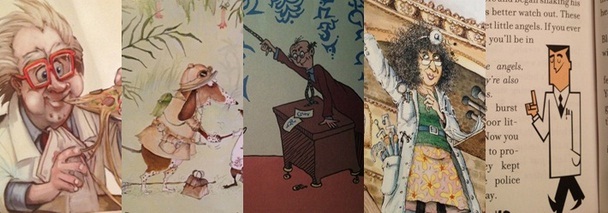Children’s Perceptions: Teachers are Girls, Scientists are Boys
 We much enjoyed Melissa Terras’ blog describing the stereotypical portrayal of academics in children’s books and comics. Melissa suggested that presenting scientists as white, male, crackpots could lead children to believe that such stereotypes were real. One way of testing this would be to examine children’s perceptions of academics, teachers and the world of science. And one way of doing this would be to examine children’s drawings.
We much enjoyed Melissa Terras’ blog describing the stereotypical portrayal of academics in children’s books and comics. Melissa suggested that presenting scientists as white, male, crackpots could lead children to believe that such stereotypes were real. One way of testing this would be to examine children’s perceptions of academics, teachers and the world of science. And one way of doing this would be to examine children’s drawings.

This article by Martin Rowley and James Hartley originally appeared on the LSE Impact of Social Sciences blog as “Mad professors revisited: Evaluating children’s perceptions of academics, teachers and the world of science” and is reposted under the Creative Commons license (CC BY 3.0).
There have been several studies that have required children to draw scientists and teachers (e.g., see Chambers, 1983; Barman, 1999; Finson, 2002; Losh, Wilke and Pop, 2008 for references. In Chambers’ large 1983 study [pdf], 4,807 children in Canada and the USA (aged 3 – 11) were asked to close their eyes and imagine a scientist at work, and then to draw what they had imagined. The drawings were then scored from 1 to 7 for the presence of each of the following features:
- Lab coat
- Eyeglasses
- Facial growth of hair (including beards, moustaches, etc.)
- Symbols of research: scientific instruments and laboratory equipment
- Symbols of knowledge: principally books and filing cabinets
- Technology: the process of science
- Relevant captions: formulae, taxonomic classification, the ‘Eureka’ syndrome
The results showed that the mean scores increased from 0.3 for kindergarten children to 3.3 for the 11-year-olds, suggesting that these stereotypical features increased as the children got older. Perhaps more interesting was the fact that more stereotypical images were found in higher-income families.
Barman (1999) replicated this study using teachers to collect data from 1,504 American pupils aged 7-8, 8-11, and 11-14, with 50 percent boys in each group. In this study the percentage of children in each age group including the features listed above were recorded. There was a marked increase in most features from children aged 7-11, and a smaller increase from children aged 11-14. Again, in this study, most of the scientists were perceived as white males.
Losh, Wilke and Pop (2008) wanted to see if this stereotypical image applied to other professions, particularly teachers. They asked 206 American 6 to 11-year-olds (50 percent males) to draw a teacher, a veterinarian, and a scientist. The results were scored for the percentage of drawings showing various features, with the following results:
“Draw a Scientist Test” compared to other professions
| Smiling | Female | Attractive | |
|---|---|---|---|
| Teacher | 83% | 70% | 42% |
| Vet | 78% | 53% | 32% |
| Scientist | 69% | 31% | 23% |
These studies do indeed suggest that children have learned to share the same views as the textbook writers referred to in Melissa’s blog. Again scientists are seen as mainly male and unattractive whereas teachers are seen as mainly female and more attractive.
Findings such as these are important with respect to the public’s understanding of both the sciences and the social sciences. They raise issues such as: (i) what values and assumptions about science and scientists should be taught in school? (ii) how teaching social science and science should be taught in ways that require students to engage in dialogue, discussion and debate, and (iii) the need for including contemporary issues and realistic concerns that students can relate to (such as climate change).
And, what fun it would be to assess the effects of such strategies by asking pupils to draw a sociologist, or even a social psychologist.



















































































